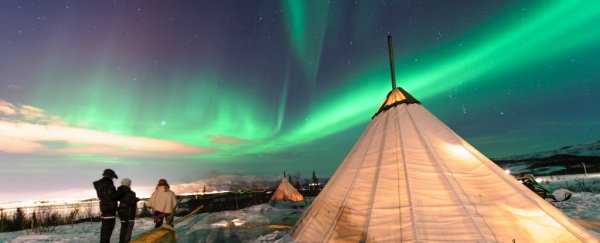On Christmas Day, a tour guide in northern Sweden recorded strange sounds which he claims were coming from the Northern Lights.
The recording, which you can hear below, is a mix of blips and crackles, and sounds like some kind of blaster weapon in a Star Wars film.
This isn't the first time someone has claimed to 'hear' the Aurora Borealis, and the evidence is building that the intense physics at play in the Northern Lights could manifest into sound. But is the recording below related to the phenomenon?
You can hear the sounds below, recorded by tour guide and photographer Oliver Wright, who works with Lights Over Lapland:
"On Christmas Night 2016, I was standing beneath an intense display of auroras in Abisko, Sweden, when I heard something that sounded like Star Wars blasters," Wright told SpaceWeather.com.
"Other bystanders heard it, too. I rushed closer to the power lines and was able to record a sample using my iPhone."
Wright said the sounds got louder and softer depending on how bright the aurora was overhead, and it was more intense the closer he moved to nearby power lines.
He said he's now heard these sounds three times - each time standing near power lines - but this was the first time he's been able to record it.
So what's going on here? People have reported hearing similar, eerie sounds, as well as "claps", coming from the Northern Lights for centuries.
Many researchers have passed this off as illusions, hallucinations, or rumours, and reliable recordings of the noises have been almost impossible to capture.
But an acoustic scientist in Finland - Unto K. Laine from Aalto University - has spent more than 15 years recording the aurora, and thinks that the Northern Lights really are producing strange noises.
He was the first person to record these sounds properly, including a spectacular series of claps in 2011, which you can hear below:
Before these recordings, one of the biggest questions surrounding - and arguments against - auroral sounds was that there was no way they could be heard all the way from Earth.
Aurorae occur when electrically charged particles excite atoms in Earth's upper atmosphere, causing them to release spectacular light. This happens around 300 km (185 miles) above the ground, and so it's unlikely any particular noises would make it that far.
But in a study published in 2012, Laine was able to calculate that the sounds were actually coming from around 70 metres (230 feet) above the ground - which explains how people could be hearing them, but didn't explain where they were coming from.
Then last year, Laine and his team finally came up with a new hypothesis that could solve that mystery once and for all.
Presenting their findings on 22 June 2016 at the Baltic-Nordic Acoustic Meeting in Stockholm, Laine showed evidence that the sounds are caused by something called the 'inversion layer' - a region of the atmosphere where the air temperature increases the higher it gets, instead of getting colder.
These inversion layers can form after calm, sunny days, when the warmer air rises after sunset as Earth's surface gets cooler.
As Andrew Fazekas explains for National Geographic:
"This inversion layer then acts like a lid, trapping negative electrical charge in the region below it and positive charge in the air above. When a geomagnetic storm hits Earth, the lid breaks and the charge is released, creating the weird sounds."
This could explain why the sounds seem to get louder and quieter with the intensity of the aurora.
So does that mean that Wright's recent recordings were to do with this same inversion layer? Probably not, says Laine, who analysed the sound for us.
"These seems to be quite hard wind on the background and due to the noise it is difficult to say what is going on," Laine told ScienceAlert. "[But] the sound has three clear resonances that hardly belong to any aurora related sounds."
What's more likely is that the noise is coming from vibrations of the power lines that Wright mentioned were nearby. For starters, it's incredibly difficult to record true auroral sounds with a phone microphone given that they're usually below 30 decibels.
And, interestingly enough, the original sound effects in Star Wars were actually made by hitting power lines.
"The blaster sounds were actually originally made by the Star Wars sound design team by bumping a steel cable," Daniel Billet, a PhD candidate specialising in aurorae, told ScienceAlert.
"In the recording it sounds pretty windy, and the author himself noted he was near electrical pylons, so this seems to be the likely cause of those particular sounds."
You can see how similar the Star Wars blaster sound effect is to Wright's recording in the video below:
But that doesn't mean the Northern Lights aren't involved in some way - but more likely by affecting the power lines somehow, rather than by producing sounds themselves.
"Still, there is a small probability, that the geomagnetic storm by inducing DC-currents to the high voltage lines is able to modulate those mechanical vibrations and thus change the sounds perceived simultaneously with the changes in the auroral display."
While the mystery surrounding this particular Christmas Day recording seems to be pretty much a case closed (sorry, the Northern Lights don't sound like Star Wars blasters), the mystery of auroral sounds is very much ongoing, and there's a lot more to learn.
"Some day these sounds will be recorded more broadly and we'll understand these mechanisms and the role of geomagnetic storms in sound production better," said Laine.
